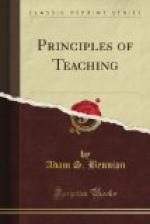The answer to this question is to be found, in part at least, in the three-fold objectives of our Church. First, the salvation and exaltation of the individual soul. As already pointed out, this is the very “work and glory” of the Father. Man is born into the world a child of divinity—born for the purpose of development and perfection. Life is the great laboratory in which he works out his experiment of eternity. In potentiality, a God—in actuality, a creature of heredity, environment, and teaching. “Why do I teach?” To help someone else realize his divinity—to assist him to become all that he might become—to make of him what he might not be but for my teaching.
Someone has jocularly said: “The child is born into the world half angel, half imp. The imp develops naturally, the angel has to be cultivated.” The teacher is the great cultivator of souls. Whether we say the child is half angel and half imp, we know that he is capable of doing both good and evil and that he develops character as he practices virtue and avoids vice. We know, too, that he mentally develops. Born with the capacity to do, he behaves to his own blessing or condemnation. There is no such thing as static life. To the teacher is given the privilege of pointing to the higher life. He is the gardener in the garden of life. His task is to plant and to cultivate the flowers of noble thoughts and deeds rather than to let the human soul grow up to weeds. This purpose becomes all the more significant when we realize that the effects of our teaching are not only to modify a life here of three-score and ten—they are impressions attendant throughout eternity. As the poet Goethe has said, “Life is the childhood of our immortality,” and the teachings of childhood are what determine the character of maturity. The thought is given additional emphasis in the beautiful little poem, “Planting,” by W. Lomax Childress:
Who plants a tree may live
To see its leaves
unfold,
The greenness of its summer
garb,
Its autumn tinge
of gold.
Who plants a flower may live
To see its beauty
grow,
The lily whiten on its stalk,
The rambler rose
to blow.
Who sows the seed may find
The field of harvest
fair,
The song of reapers ringing
clear,
When all the sheaves
are there.
But time will fell the tree,
The rose will
fade and die,
The harvest time will pass
away,
As does the song
and sigh.
But whoso plants in love,
The word of hope
and trust,
Shall find it still alive
with God—
It is not made
of dust.
It cannot fade nor change,
Though worlds
may scattered be,
For love alone has high repose
In immortality.
If the teacher, as he stands before his class, could project his vision into the future—could see his pupils developed into manhood and womanhood, and could see all that he might do or fail to do, he would read a meaning well-nigh beyond comprehension into the question, “Why do I teach?”




